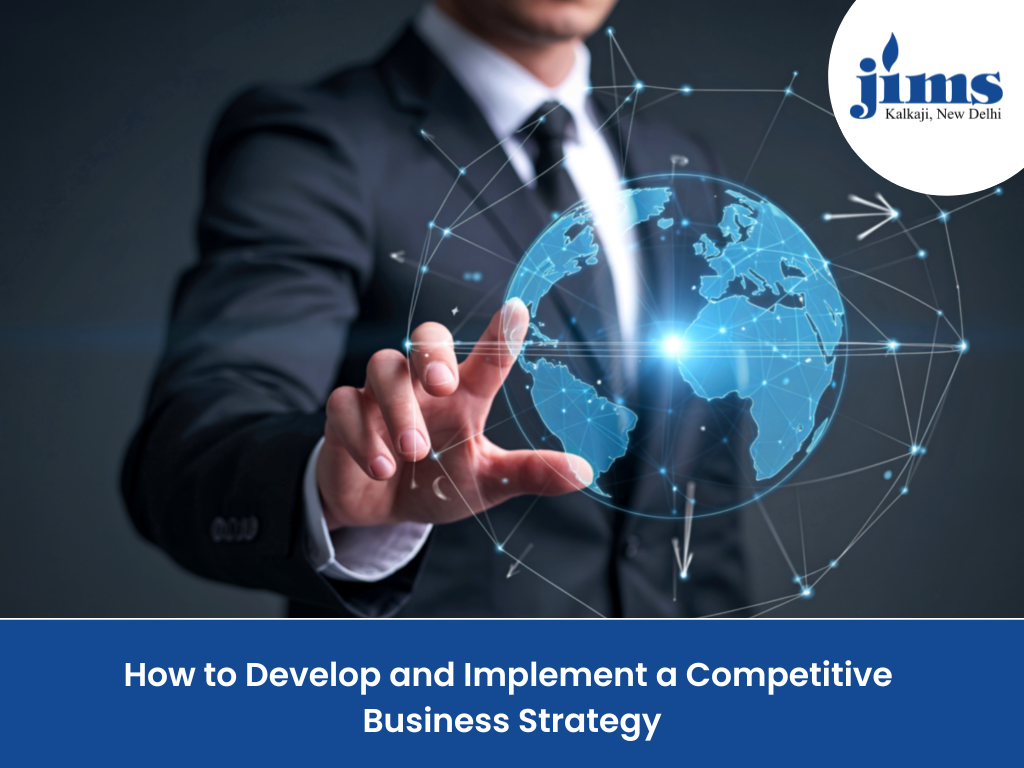In today’s fast-paced and ever-evolving business environment, developing and implementing a competitive business strategy is essential for the long-term success and sustainability of an organization. A well-thought-out strategy enables businesses to differentiate themselves from competitors, increase profitability, and adapt to changes in the marketplace. Whether you are a start-up looking to establish yourself or an established company aiming to improve market share, creating a competitive strategy is critical. JIMS Kalkaji, being one of the best MBA college in Delhi, plays a pivotal role in equipping future leaders with the knowledge and skills required to develop and implement such strategies effectively.
This article provides a comprehensive guide on how to develop and implement a competitive business strategy that can lead to sustainable growth and a strong market position.
Understand the Market Landscape
The first step in developing a competitive business strategy is understanding the market landscape. This includes identifying industry trends, evaluating your competitors, and gaining insights into customer preferences. A solid understanding of the market allows businesses to identify opportunities and threats, positioning them to take advantage of favorable conditions and mitigate potential risks.
-
Market Research and Analysis
Market research is the foundation of any effective strategy. It involves gathering and analyzing data related to market size, growth rate, customer demographics, buying behaviors, and competitors. Businesses can utilize both primary and secondary research methods to gather data. Primary research may include surveys, focus groups, and interviews, while secondary research includes industry reports, competitor websites, and financial data.
-
Competitor Analysis
Understanding your competitors’ strengths, weaknesses, and strategies is vital in developing a competitive edge. Perform a competitor analysis by evaluating their product offerings, pricing strategies, marketing tactics, and customer service practices. Identify areas where your business can outperform them, either by offering a better product, improving customer experience, or utilizing cost-effective solutions.
-
SWOT Analysis
A SWOT analysis (Strengths, Weaknesses, Opportunities, and Threats) is a powerful tool that allows businesses to assess their internal capabilities and external market factors. By identifying your company’s strengths and weaknesses, as well as opportunities and threats in the market, you can develop a strategy that leverages your strengths and minimizes your weaknesses. This analysis should be regularly updated to ensure that your strategy remains relevant in a changing market.
Define Your Unique Value Proposition (UVP)
A Unique Value Proposition (UVP) is what sets your business apart from the competition and highlights the value you bring to customers. A strong UVP addresses customer needs, solves their pain points, and offers something that competitors cannot easily replicate. Defining your UVP is crucial for positioning your business in the market and building a loyal customer base.
-
Identify Customer Pain Points
Understanding customer pain points is essential for crafting a compelling UVP. What are the challenges that your customers face, and how does your product or service solve them? Focus on the problems that are not being effectively addressed by competitors, and offer a solution that stands out. Conduct customer interviews and surveys to gather insights about what customers value most and what frustrates them about existing products or services.
-
Differentiate Your Offering
Your UVP should clearly communicate what makes your product or service unique. Whether it’s through superior quality, innovative features, exceptional customer service, or a unique business model, your offering must stand out in the marketplace. Focus on the aspects that matter most to your target audience, such as convenience, affordability, or exclusivity.
-
Refine Your Brand Messaging
Your UVP should be woven into every aspect of your brand messaging, from your website copy to your social media presence. Clear, consistent messaging helps customers understand your business’s value and why they should choose you over your competitors. Develop a tagline or slogan that encapsulates your UVP in a succinct and memorable way.
Set Clear Business Objectives
A competitive business strategy must be built on clear, measurable objectives. These objectives guide the direction of your business, ensuring that all efforts align with long-term goals. Setting specific, measurable, attainable, relevant, and time-bound (SMART) goals is essential for driving performance and achieving success.
-
Set Long-Term Goals
Long-term goals should focus on overall business growth, market expansion, or industry leadership. These goals provide a vision for the future and serve as a guiding force for the development of shorter-term objectives. For example, a long-term goal might be to become the market leader in your industry within the next five years or to expand your business into international markets.
-
Set Short-Term Goals
Short-term goals should be aligned with long-term objectives and broken down into actionable steps. These goals may include increasing sales by a certain percentage, launching new products, expanding customer base, or improving operational efficiency. Monitoring short-term progress will help you stay on track and make adjustments when necessary.
-
Key Performance Indicators (KPIs)
KPIs are the measurable values that help businesses track their progress toward achieving their goals. Financial KPIs, such as revenue growth, profitability, and return on investment (ROI), as well as non-financial KPIs like customer satisfaction and brand awareness, should be monitored regularly. KPIs allow businesses to evaluate performance, identify areas of improvement, and make data-driven decisions.
Develop a Tactical Plan
A strategic plan is only as good as its execution. Once you have defined your objectives, it’s time to develop a tactical plan that outlines the specific actions required to achieve them. A tactical plan should detail how resources will be allocated, timelines for completing tasks, and who will be responsible for each action.
-
Resource Allocation
Identify the resources required to execute your strategy, including financial capital, human resources, technology, and time. Allocating resources efficiently ensures that the right efforts are being made at the right time and that the necessary investments are in place to drive growth.
-
Marketing and Sales Strategy
A strong marketing and sales strategy is essential for driving awareness, attracting customers, and closing deals. Your marketing strategy should include online and offline tactics such as digital marketing, content creation, SEO, social media, public relations, and paid advertising. A well-thought-out sales strategy ensures that the leads generated from marketing efforts are converted into paying customers.
-
Operational Strategy
The operational side of your business must also be optimized to support your competitive strategy. This includes streamlining supply chains, improving manufacturing processes, optimizing customer service, and implementing efficient workflows. By focusing on operational efficiency, you can reduce costs, improve product quality, and deliver better service to customers.
Implement and Monitor Your Strategy
Once your strategic and tactical plans are in place, the next step is to implement the strategy effectively. Effective implementation requires strong leadership, team alignment, and continuous monitoring to ensure that everything stays on track.
-
Leadership and Team Alignment
Ensure that all leaders within the organization are aligned with the strategy and are effectively communicating the vision to their teams. Leadership plays a critical role in motivating and inspiring employees to execute the strategy and contribute to the company’s success.
-
Regular Monitoring and Evaluation
A competitive business strategy is not static. It requires continuous monitoring and evaluation to assess progress and adjust tactics as needed. Regularly review KPIs, market trends, and internal performance to ensure that the strategy remains relevant and effective. Be open to making adjustments based on market shifts, customer feedback, and internal challenges.
-
Agility and Flexibility
In a competitive business environment, agility is key. Being able to adapt quickly to changes in the market or unforeseen challenges is crucial for staying ahead of competitors. Your strategy should have built-in flexibility to pivot when necessary, whether it’s adjusting your product offering, revising marketing strategies, or shifting resources to different initiatives.
-
Foster a Continuous Improvement Culture
A competitive business strategy is an ongoing process of refinement. Encourage a culture of continuous improvement within your organization, where employees are empowered to suggest improvements, test new ideas, and innovate. Foster an environment where feedback is welcomed, and learnings from both successes and failures are used to refine the strategy.
-
Employee Engagement and Innovation
Engage employees at all levels in the strategy-making process. Employees who feel involved in the decision-making process are more likely to be motivated and aligned with the company’s goals. Create channels for feedback and encourage innovation by providing training, resources, and the freedom to experiment with new ideas.
Conclusion
Developing and implementing a competitive business strategy is not a one-time task but an ongoing process that requires careful planning, execution, and regular evaluation. By understanding the market landscape, defining a unique value proposition, setting clear objectives, developing a tactical plan, and fostering a culture of continuous improvement, businesses can position themselves for long-term success in a competitive environment.
With the right approach and commitment to execution, any business—large or small—can develop a strategy that drives growth, enhances profitability, and ensures sustained competitiveness in an ever-changing marketplace

